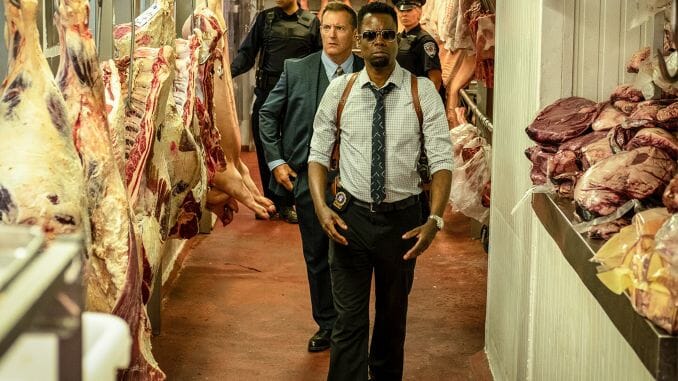Spiral Came, It Saw, It Squandered

The Saw franchise’s core concept is so pure and visceral that it could be rebooted and revisited endlessly, despite its labyrinthine canon. Departing from Jigsaw’s petty revenges and cultish followers to find an unrelated—yet inspired—new crop of torturers and victims would always be the right idea for the much maligned horror series. Adding Chris Rock to the fold as its new face, an idealistic detective investigating a true-blue copycat killer, is as refreshing a slate-cleaning as this franchise could ask for, and with a star whose very presence in that franchise is immediately intriguing. But despite it all, we seem to keep spiraling down, down, down the drain. Maybe it’s because Spiral brings back both Saw II, III and IV director Darren Lynn Bousman and the Jigsaw writing team, but the would-be reboot is just wandering the same worn circle.
Rock plays Zeke, the golden boy cop—son of the overbearing former chief (Samuel L. Jackson)—whose fellow officers hate him for snitching on a crooked member of the precinct. When cops start dying in suspiciously complicated ways (and some meticulously painted spirals tease a connection to horror’s most famous murderous puppeteer), Zeke takes point on the investigation.
Unfortunately, the casting novelty wears off quickly. Rock’s dramatic instruments seem to be calibrating right in front of us: Eyes undecided between bugged or squinted, hard frown conveying discomfort more than rage or frustration. Bigger emotions appear in jagged smash cuts, interspersed as wildly as Rock’s own ultra-serious tics. Line deliveries fall flat unless they’re specifically attuned to his strengths. And yet his charisma is indisputable. When he’s commanding attention as he addresses a room or cracking wise as he busts the balls of his rookie partner (Max Minghella), Rock is everything we need him to be. He’s a beacon. Levity and power. A needed cathartic presence used too little in a movie filled with half-tortured corpses. He references New Jack City, a movie that he appears in, and you know what? It still works despite the metaphysical questions it raises about the Saw universe.
Rock is even shot well by cinematographer Jordan Oram, who manages to find a few nice isolating or chaotically controlled compositions amidst the mostly functional camerawork—if you can spot them. Saw II’s haphazardly slicing Razor Box trap seems to have been hired to edit Spiral with its blindly applied blades. That sloppy craftsmanship spills over to basically every other element of the film, sadly including its most important selling point.
The key to the Book of Saw, as I guess we’re now calling this franchise, is contained (sometimes literally) in its torture devices. Spiral’s look even more like erector set jumbles than usual, not helped by Bousman digitally shaking his camera around like it owes him money. There are engagingly over-the-top ideas at play in most of these set-ups—the hilarious attempts at ironic symbolism would leave Alanis Morissette shaking her head—and the new “wanna play a game” voice is equally silly, but they’re almost all shot too confusingly to be either intimidating, gruesome or even perversely enjoyable for their sheer convolution. Our imaginations don’t fill in the painful gaps because we’re too busy trying to figure out what’s going on and how the contraptions actually work. What’s pulling on what? How are these people supposed to get out? What exactly is bleeding all over the floor? There’s maybe one or two involuntary cringes to be had (and the best is squandered first in a decent opening scene), but these are old tricks performed poorly.
-

-

-

-

- Curated Home Page Articles By Test Admin October 21, 2025 | 3:10pm
-

- Curated Home Page Articles By Test Admin October 21, 2025 | 2:57pm
- Urls By Test Admin October 21, 2025 | 2:57pm
- Curated Home Page Articles By Test Admin October 21, 2025 | 2:55pm
-

-

-

-

-

-

-

-

-

-

-

-

-

-

-

-

-

-

-

-

-

-

-

-

-

-

-

-

-

-

-




































